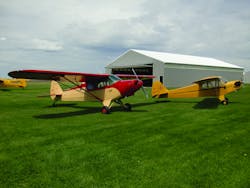Cover Story: Vintage Piper Restoration
Natural fabric materials such as cotton and linen were primarily used for covering the structure of both small and large aircraft back in the day. However the use of fabric covering materials continues to be widely used on many new manufactured aircraft, for restoration of antique and vintage aircraft, and of course used by builders of many experimental and recreational aircraft. Many factors determined the lifespan of fabric covering primarily the environment the aircraft operates in and whether it’s stored inside or outside. On average natural fabrics would last a decade; or more or less.
A benefit if you will, of routinely removing the covering of these older aircraft is that mechanics and owners had the ability to regularly inspect, clean, repair, treat, and paint the generally steel, aluminum, and wood materials used to construct these vintage aircraft.
As a result of longer lifespan synthetic fabrics, one can argue the structure underneath may not be subject to a thorough cleaning and inspection as often as it once had, supporting the need for diligent preparation of the structure being covered. Moisture ingestion in hidden areas, spilled chemicals and oils, dissimilar metals, and other corrosion causing features, may have longer periods of time to attack and do damage. Many areas prone to corrosion are covered and hard or even impossible to access making it difficult to spot corrosion forming.
To talk more about restoring and recovering vintage airplanes, I turned to my good friends at Stanton Sport Aviation where they recently restored a 1947 Piper PA-12 Super Cruiser and a 1946 Piper J-3 Cub. Both aircraft were originally manufactured using natural fabrics for covering.
Under the fabric
The fuselages like similar aircraft of this period are a truss built structure using chromium molybdenum steel 4130 tubing or commonly referred to as “chrome moly”. Originally the steel parts were painted with a common use primer of the day; how many of you recall the thin green appearing zinc chromate primer? Both wood and aluminum were used for fuselage stringers, floor boards, and miscellaneous other features. The wings for both these airplanes were constructed using aluminum spars and wing-ribs.
The first step to any restoration is the careful disassembly, that is if it’s still assembled, and it’s advisable to keep a detailed journal of how the aircraft came apart with lots of diagrams and photographs. The entire airplane and all the attaching parts need a thorough cleaning and detailed inspection.
Typical discrepancies encountered can be cracked, bent, dented, and of course rusted tubing and other steel parts, as well as the occasional cracked weld-joint or fitting. A close inspection of the lower fuselage structure particularly on tail-wheel type aircraft near the tail-post area will generally discover tubing in need of repair or replacement. Other areas prone to rust are those subject to water ingestion such as near the landing gear, windows, doors, and other openings.
Kent Johnson, A&P mechanic and manager of Stanton Sport Aviation, says, ”On the Cruiser we found both the left and right side rear window channels completely rusted through due to moisture ingestion. They likely had been that way for years but until the airplane was disassembled and the fabric removed this went undetected.”
Rust on the outer surface of tubing will be easily seen, but corrosion caused by moisture that has penetrated its way inside the tubing can be difficult or impossible to detect. Rust can be hiding inside these 60 plus year old fuselages and attack the steel structure on the inside of the tubing as well as the outer surfaces. One method used to find corroded and weak tubing is to apply pressure using a sharp instrument such as an awl to corroded or suspected areas of tubing. With most tubes having thin wall thicknesses, a rusted tube will be weakened resulting in the awl denting or penetrating the tubing, identifying an area in need of repair or replacement. Also look for obvious signs such as rust-red discoloration and flaking.
A similar inspection of the aluminum wings and related parts is also a must. Johnson explains, “The aluminum spars on the J-3 ailerons had significant corrosion under some of the hinges. It appears these hinges were not removed for a long time including at the last recovering,” says Johnson. He noted the matting surfaces on the hinges were not rusted, yet the aluminum under them was badly corroded.
Cleaning, painting, and new fabric
Johnson says, “After making needed repairs to the fuselages all the steel parts were cleaned down to bare metal using media blast.” He went on to discuss different types of media and grit used for cleaning and the importance with selecting a material not too abrasive as to damage the tubing. Once cleaned all the steel parts were immediately cleaned and painted with an epoxy primer.
“Even a short period of bare steel in a humid environment, or the finger prints from handling the bare parts will be enough contamination to start the rust process,” Johnson says. Today’s epoxy primers withstand environmental conditions much better than the old paints and are compatible with the fabric cements used to attach the fabric to the steel tubing. Also, there are approved corrosion inhibitors available for flushing and coating the inside of steel tubing if you choose.
There are a few different types of synthetic fabric available today and approved with a supplemental type certificate (STC) for use on vintage airplanes. The covering material used on both these airplanes was Ceconite. Hank Geissler, A&P mechanic and Stanton’s primary dope and fabric person, says, “All of the covering systems available today have pros and cons and your choice is dependent upon what kind of finish you want. I’ve used most of them and just happen to like using Ceconite fabric with Randolph Aircraft Products nitrate and butyrate dope.”
After the fabric is installed and heat-shrunk, two coats of clear nitrate dope were applied. “One thing I like is to spray all the dope onto the fabric to eliminate brush marks, and I adjust the thinning percentages depending on which coat I apply,” says Geissler. Next is rib-stitching, adding fabric tape to the wings, along with all the extra layers of fabric added to corners and other areas where the fabric directly touches the structure underneath.
Then one more coat of clear butyrate and a series of butyrate coats with silver pigment added to protect the fabric against damage caused by sunlight. “We lightly sand in-between coats with 280 and later 320 grit sandpaper. Before the final color I like to paint all the fabric parts with a white base coat first. It seems to provide a consistent base and enhances the final color. I used three coats of color with a 400 grit sanding after the first and second coats.”
Geissler ends by saying, “Most people develop their own individual techniques and these are mine.” He goes on to say, “Don’t think the final color coats will cover imperfections; they won’t. You need to be careful and neat all the way through the process.”
Stanton Sport Aviation Inc. is a full-service FBO providing pilot training, airplane rental including tailwheel and LSA, maintenance, restoration, and aircraft storage, located at Historic Stanton Airfield in Minnesota. Stanton Airfield is a shareholder owned private airfield open to the public providing a place for recreational and sport aviation enthusiast to enjoy aviation. AMT editor Ron Donner has been a volunteer and member of the board of directors for more than 10 years. More information can be found by visiting www.stantonairfield.com.

